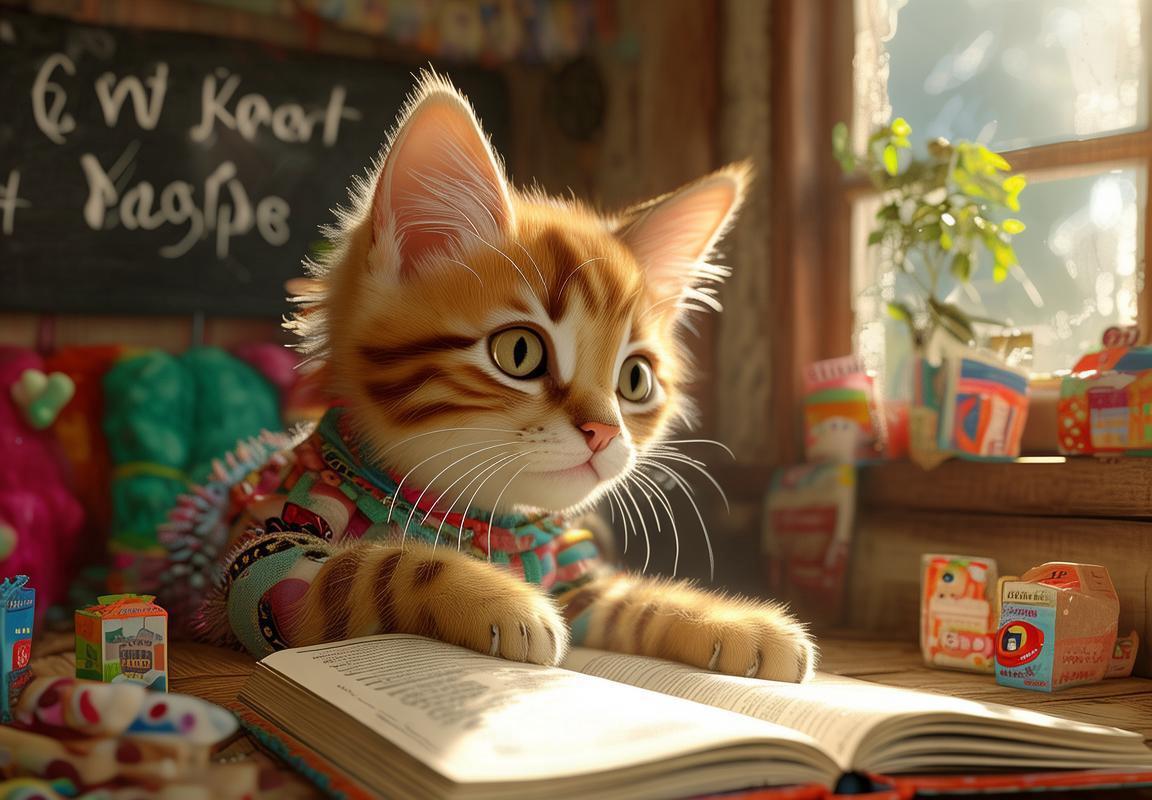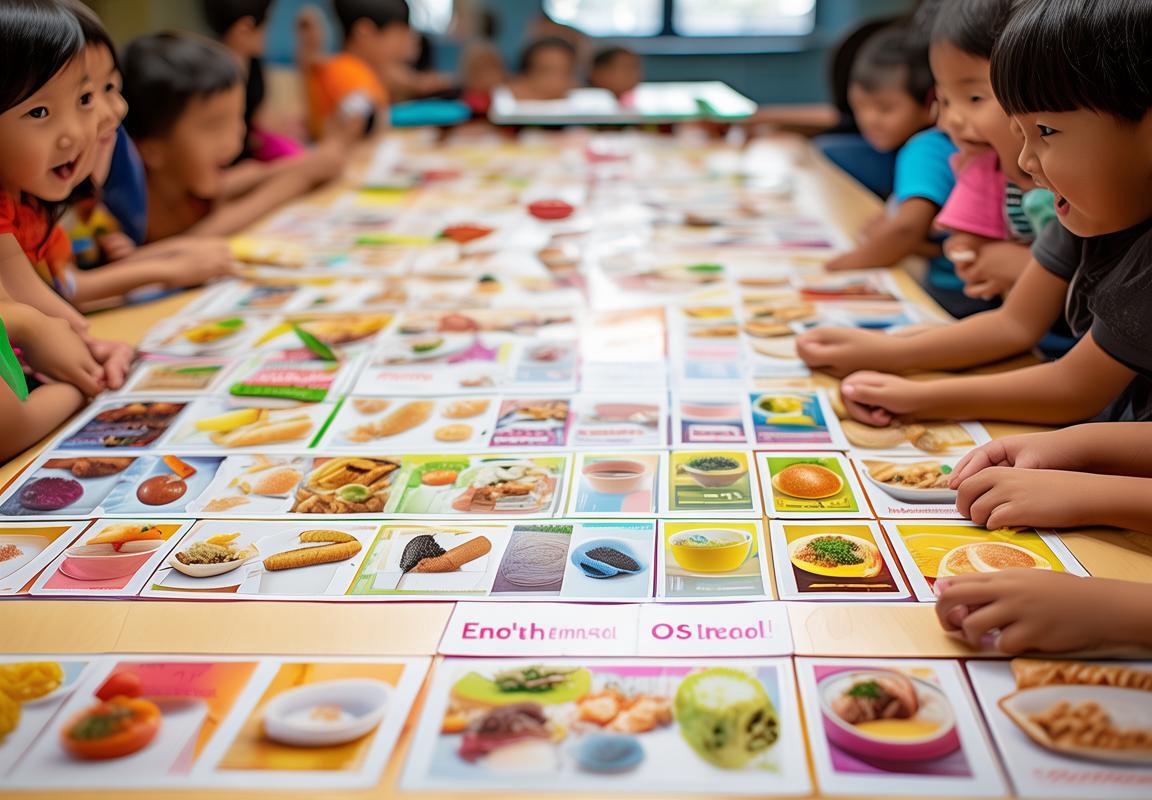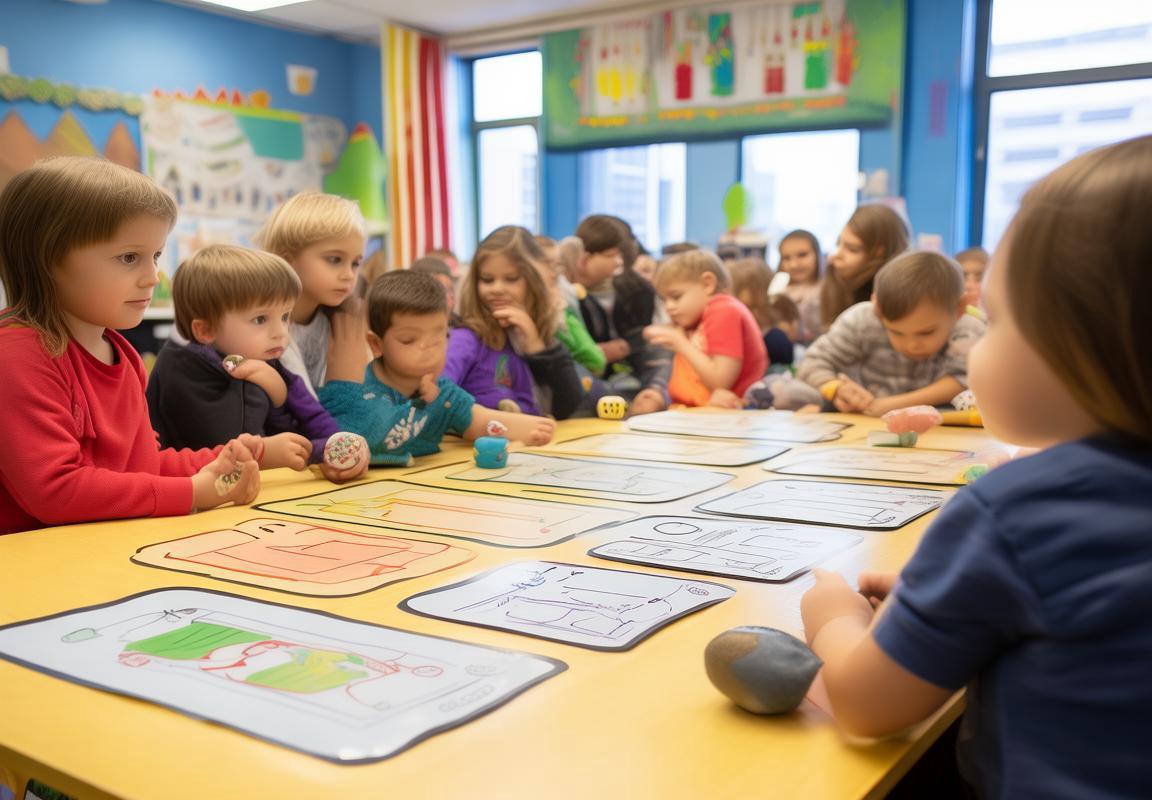เราจะพาเด็กเล็กๆสำหรับเล่นเกมสนุกและเรียนรู้ภาษาอังกฤษด้วยวิธีที่น่าสนุกและมีประโยชน์!
ภาพและคำศัพท์
เรื่องเล่าเกี่ยวกับน้องแมวที่เรียนภาษาอังกฤษ
Once upon a time, in a cozy little village, there lived a curious cat named Whiskers. Whiskers was not just any ordinary cat; he loved to learn new things. One sunny morning, Whiskers decided to learn English to communicate with his new friend, a little boy named Timmy.
Whiskers spent his days following Timmy around the village, listening to him speak in English. Timmy was kind and patient, teaching Whiskers simple words like “cat,” “dog,” and “house.” Whiskers was fascinated by the new sounds and words he heard.
One day, Timmy took Whiskers to the library, where they found a book about English grammar. Timmy read aloud to Whiskers, and the cat listened intently. He learned about verbs, nouns, and adjectives, and even tried to use them in his own sentences.
As Whiskers continued to learn, he realized that English was not just a language but a way to explore the world. He wanted to travel and meet new friends. Timmy, understanding Whiskers’ dreams, decided to take him on an adventure.
They packed their bags and set off on a journey to a faraway land. Along the way, they met a wise old owl who spoke English fluently. The owl taught Whiskers more advanced vocabulary, such as “expedition,” “exploration,” and “adventure.”
Their first stop was a beautiful forest filled with colorful flowers and tall trees. Whiskers saw a squirrel and tried to say “squirrel” in English. The squirrel, surprised, replied in English, “Hello, Whiskers! I’m Nutty!”
Next, they visited a bustling city with tall buildings and busy streets. Whiskers saw a dog and tried to say “dog” in English. The dog wagged its tail and said, “Good boy, Whiskers!”
As they continued their journey, Whiskers became more confident in his English skills. He could now understand and speak to animals in different places. Timmy was proud of his little friend and knew that Whiskers was ready for more adventures.
Finally, they reached a magical island with sparkling beaches and crystal-clear water. Whiskers saw a fish and tried to say “fish” in English. The fish swam up to Whiskers and said, “Hello, Whiskers! Welcome to my underwater world!”
Whiskers felt happy and accomplished. He had learned so much on their journey, and he was grateful to Timmy for teaching him English. They returned to the village, where Whiskers became the village’s favorite cat, known for his ability to speak English and make new friends.
And so, Whiskers and Timmy continued their adventures, exploring new places and learning new things together. The end.

เกมการจับคู่
เกมการจับคู่คำศัพท์ภาษาอังกฤษกับภาพของอาหารที่เด็กชอบ สามารถถูกสร้างขึ้นดังนี้:
- ภาพของอาหาร
- ใช้ภาพของอาหารต่างๆ อย่างเช่น แฟร์น, น้ำแก้ว, ขนม, ซอยส้ม, และอื่นๆ ที่เด็กชอบ
- ประกาศภาพแต่ละภาพด้วยภาษาอังกฤษ เช่น “What’s this? This is an apple.”
- คำศัพท์ในแถวด้านบน
- เขียนคำศัพท์ของอาหารที่เหมาะกับภาพที่ตรงข้าม ในแถวด้านบนของกระดานเล่นหรือผ้าคราบ
- ตัวอย่าง: “Apple”
- ภาพในแถวด้านล่าง
- ใส่ภาพของอาหารที่เหมาะกับคำศัพท์ที่มีอยู่ในแถวด้านบน ในแถวด้านล่างของกระดานเล่นหรือผ้าคราบ
- ตัวอย่าง: ภาพของแฟร์นตรงข้ามกับคำศัพท์ “Apple”
- เกมการจับคู่
- ให้เด็กจับคู่ภาพกับคำศัพท์ที่เหมาะกัน
- ตัวอย่าง: เด็กจับคู่ภาพของแฟร์นกับคำศัพท์ “Apple”
- ตอบแทนหรือรางวัล
- ให้เด็กรับรางวัลหรือตอบแทนเล็กๆ ทุกครั้งที่เขา/เธอจับคู่สำเร็จ
- อาจเป็นแบบฝึกหัดเรียนรู้ที่มีสนุกสนาน
- การวิเคราะห์และการปรับเปลี่ยน
- อาจเพิ่มความยากด้วยการเพิ่มจำนวนภาพและคำศัพท์
- อาจเปลี่ยนแปลงภาพและคำศัพท์เพื่อเป็นการเล่นเกมอีกครั้ง
ด้วยวิธีนี้ เด็กจะสามารถเรียนรู้คำศัพท์ในภาษาอังกฤษที่เกี่ยวข้องกับอาหารโดยมีการสนุกสนานและเข้าใจง่ายกว่านั้น

การปลดภาพ
- เลือกภาพแบบตัวแบบ
- ใช้ภาพของสิ่งแวดล้อมต่างๆ แบบตัวแบบ ซึ่งเป็นภาพขาวของสิ่งแวดล้อมนั้น
- ภาพอาจเป็นต้นไม้, หน้าต่าง, รถยนต์, หอคอย, ฯลฯ
- วาดสีและภาพ
- ให้เด็กทายและวาดสีที่เหมาะสมกับภาพตัวแบบ
- หากเป็นภาพต้นไม้ เด็กอาจวาดสีเขียว
- หากเป็นภาพหน้าต่าง เด็กอาจวาดสีขาวหรือสีสันที่เหมาะสม
- จับคู่ภาพกับคำศัพท์
- ให้เด็กจับคู่ภาพที่วาดสีกับคำศัพท์ที่เหมาะสม
- ฉบับอย่าง: ภาพต้นไม้จับคู่กับคำศัพท์ “tree”
- ภาพหน้าต่างจับคู่กับคำศัพท์ “window”
- การตรวจหาคำศัพท์
- ให้เด็กตรวจหาคำศัพท์ที่ซ่อนอยู่ในภาพที่วาดสี
- ฉบับอย่าง: ให้เด็กหาคำศัพท์ “sun” ในภาพที่มีทางรายละเอียดของสุนัข, ฝน, ตาแดด, และฝาย
- รางวัลและการตอบแทน
- ให้รางวัลหรือรางานเล็กๆ ให้กับเด็กที่แข็งแรงในการเล่นเกม
- รางวัลอาจเป็นของเล่น, หรือการแตะยอมเล็กๆ
- การเรียนรู้ทางการสัมพันธ์
- ให้เด็กเรียนรู้การสัมพันธ์ระหว่างภาพและคำศัพท์
- ฉบับอย่าง: ภาพต้นไม้และคำศัพท์ “tree” ช่วยเด็กจำที่ต้นไม้เป็นสิ่งมีชีวิต
- การปรับปรุงทักษะการเรียนรู้
- ให้เด็กลองเล่นเกมมากกว่าหนึ่งครั้งเพื่อปรับปรุงทักษะการเรียนรู้
- การเล่นเกมที่ตลอดเวลาช่วยเด็กในการจำและจดจำคำศัพท์และภาพ
- การสร้างสรรค์
- ให้เด

เกมการทาย
- เลือกภาพ
- ใช้ภาพของสิ่งของที่มีลักษณะทางภายนอกต่างๆ อย่างเช่น ต้นไม้, หน้าต่าง, รถยนต์, หอคอย, ฯลฯ และตักแบบของสิ่งนั้นบนกระดานเล่นหรือผ้าคราบเล็กๆ
- ทายภาพ
- ให้เด็กทายภาพที่มีตักแบบ
- ให้เด็กพยายามจะบอกชื่อของสิ่งที่พวกเขาทายมา
- ชั้นนำ
- ให้เด็กที่ทายถูกชั้นนำเขียนชื่อของสิ่งที่พวกเขาทายมาบนกระดานเล่นหรือผ้าคราบ
- ให้เด็กต่อเนื่องทายภาพต่อไปจนกว่าทุกภาพที่มีตักแบบจะถูกทาย
- ให้เด็กตรวจสอบที่ไรที่ผิดและช่วยกันแก้ไข
- รางวัล
- ให้รางวัลหรือตอบแทนเล็กๆ ให้กับเด็กที่ทายถูกเยอะที่สุด
- ครั้งหนึ่งที่เด็กทั้งหมดทายทั้งหมดแล้ว ให้เด็กชอบได้รับรางวัลที่เหมาะสม
- การปลดภาพ
- หลังจากที่เด็กทั้งหมดทายทั้งหมดแล้ว ให้เด็กปลดภาพที่มีตักแบบและเขียนชื่อของสิ่งที่มีตักแบบบนภาพ
- ให้เด็กชอบได้ดูภาพและอ่านชื่อของสิ่งที่มีตักแบบ
- การทบทวน
- ให้เด็กทบทวนภาพและชื่อของสิ่งที่มีตักแบบเพื่อความเข้าใจและจำได้ดีขึ้น
ด้วยวิธีนี้ เด็กจะสามารถเรียนรู้คำศัพท์ในภาษาอังกฤษที่เกี่ยวข้องกับสิ่งแวดล้อมโดยมีการสนุกสนานและเข้าใจง่ายกว่านั้น

เกมการตรวจหาคำศัพท์
เริ่มจากภาพของสิ่งแวดล้อมที่เด็กรู้จักเหมือนกัน อาจเป็น ฝาที่ร้อนแดดออก หรือ ต้นไม้ที่เติบโต หรือ รถยนต์ที่เดินทางแหวก แล้วขึ้นมาเป็นคำศัพท์ที่ซ่อนอยู่ด้วยเสียงของสิ่งแวดล้อมนั้นเช่นนี้:
- ฝาที่ร้อนแดดออก
- ภาพ: ฝาที่ร้อนแดดออก
- คำศัพท์: “hot”
- ภาพ: ดวงอาทิตย์ที่ร้อน
- คำศัพท์: “sun”
- ต้นไม้ที่เติบโต
- ภาพ: ต้นไม้ที่เติบโต
- คำศัพท์: “green”
- ภาพ: ใบไม้ที่เขียว
- คำศัพท์: “leaf”
- รถยนต์ที่เดินทางแหวก
- ภาพ: รถยนต์ที่เดินทางแหวก
- คำศัพท์: “red”
- ภาพ: สีของรถยนต์
- คำศัพท์: “car”
เด็กจะต้องหาคำศัพท์ที่ซ่อนอยู่ในภาพต่างๆ แล้วเขียนมาด้วยตัวเอง หรืออาจแสดงให้เห็นตามที่เขียนไว้ด้วยสีเส้นของสีที่เหมาะสมกับภาพ
ตัวอย่างกาลกระบวนเกม:
- แสดงภาพ:
- แสดงภาพของฝาที่ร้อนแดดออกและดวงอาทิตย์ที่ร้อน
- บอกคำศัพท์:
- “What color is the sun? It is yellow.”
- “What color is the car? It is red.”
- หาคำศัพท์:
- “Can you find the word ‘hot’ in the picture?”
- “Can you find the word ‘red’ in the picture?”
- ขอให้เด็กเขียนคำศัพท์:
- “Write the word ‘hot’ here.”
- “Write the word ‘red’ here.”
- ตัวอย่างแสดงภาพต่อไป:
- แสดงภาพของต้นไม้ที่เติบโตและใบไม้ที่เขียว
- “What color is the leaf? It is green.”
- “What color is the tree? It is green.”
- ขอให้เด็กเขียนคำศัพท์ต่อไป:
- “Write the word ‘green’ here.”
- “Write the word ‘leaf’ here.”
- ตัวอย่างแสดงภาพสุดท้าย:
- แสดงภาพของรถยนต์ที่เดินทางแหวก
- “What color is the car? It is red.”
8
